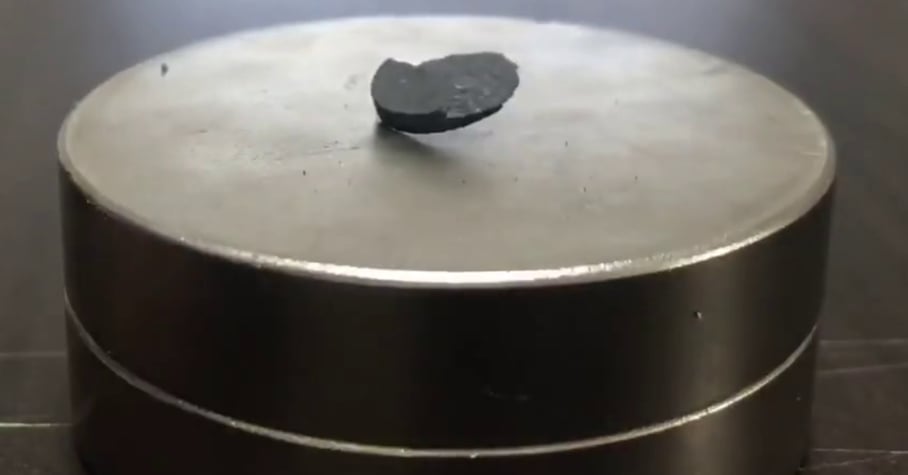
The last few weeks have seen the rise of an unlikely social media star – the claimed room-temperature superconductor known as LK-99. A video of the material levitating – one possible hallmark of superconductivity – has gained traction on social media, following a South Korean group’s pre-print publication about the material. But is LK‑99 the real deal, a false dawn, or something in between?
Superb conductors
A superconductor is a material with zero electrical resistance, and which acts as a perfect diamagnet (the so called “Meissner effect”). Many superconducting materials are known, but most only work under unhelpful conditions: typically extremely low temperatures and high pressures.
Creating superconductors which operate at ambient temperatures and pressures is eminently desirable, with potential applications spanning all types of industry and technology.
One of the most popular superconductors in use today is rare-earth barium copper oxide (ReBCO). A high-temperature superconductor, ReBCO provides superconductivity at above 77 K (-196 °C). While undeniably cold, 77 K is above the boiling point of liquid nitrogen, meaning it is relatively easily attainable and avoids the need for highly specialist, and costly, liquid helium.
Nonetheless, due to the cold temperatures needed for these high-temperature superconductors, the use of superconductors is reserved for high-value, specialist technology areas (e.g., MRI, NMR, particle accelerators and experimental fusion reactors). However, true room-temperature superconductors could open up superconductivity to “everyday” large-scale applications.

Pellet of LK-99 being repelled by a magnet (Credit: Hyun-Tak Kim)
LK-99
Work from the Quantum Energy Research Centre based in Seoul, South Korea suggests that LK-99 may be the first ambient temperature and pressure superconductor.
LK-99 was first prepared in 1999. However, the specific “superconducting” phase is thought to have been isolated in the last few years. A patent application filed in 2020 relates to a method of manufacturing superconductor containing ceramic composites, and a more recent patent application filed in late 2021 appears to describe the room-temperature superconductor itself.
Videos of levitating LK-99, published in early 2023, have captured global attention as well as scepticism, with many quick to note that mere levitation is possible for all diamagnets, not just superconductors. Indeed, Andre Geim won the satirical 2000 Ig Nobel Prize in Physics for levitating a live frog with magnets (the frog wasn’t superconducting).
Causing this scepticism is a raft of previous false reports of room-temperature superconductors. Only last year, Nature retracted a paper relating to the first room-temperature (and high-pressure) superconductor, as doubts about the re-producibility of the study surfaced.
At the time of writing, a handful of computational studies have confirmed that LK-99 could achieve room-temperature superconductivity (from Shenyang, China and Berkeley, California). However, mechanisms underpinning superconductivity are mysterious and varied, so modelling can only provide indications. It's likely to take time for the claims around LK-99 to be reproduced, validated and peer-reviewed.
It's also yet to be seen how practical LK-99 is in real-world applications. The attraction of current market-leading superconductor, ReBCO, is its relative ease of manufacture, toughness and ability to be made into useful superconducting “wires”. It is likely that similar properties will be needed for any room-temperature superconductor to achieve mainstream adoption.
The bold claims surrounding LK-99 have captured public interest and raised the profile of superconductors. With our keen eye on innovation and intellectual property at Mewburn Ellis, we are certainly looking forward to seeing if and how LK‑99 and any other promising superconductors develop further.
Niles is a Patent Attorney working in the chemistry field. Niles has an MChem degree in chemistry from the University of Oxford. His undergraduate research project was on the synthesis of novel perylene diimide containing macrocycles for anion recognition and sensing applications.
Email: niles.beadman@mewburn.com
Sign up to our newsletter: Forward - news, insights and features
Our people
Our IP specialists work at all stage of the IP life cycle and provide strategic advice about patent, trade mark and registered designs, as well as any IP-related disputes and legal and commercial requirements.
Our peopleContact Us
We have an easily-accessible office in central London, as well as a number of regional offices throughout the UK and an office in Munich, Germany. We’d love to hear from you, so please get in touch.
Get in touch

